Research on Employee Retention for Company Performance: Montcalm Hotel
VerifiedAdded on 2021/02/21
|24
|5297
|69
Report
AI Summary
This research project investigates the critical role of employee retention in enhancing organizational performance, using Montcalm Hotel as a case study. The report begins with an introduction outlining the rationale, research aims, objectives, and questions, followed by a detailed literature review that explores the concept of employee retention, its impact on organizational development, and various strategies for implementation, such as competitive salaries, conducive work environments, and work-life balance. The research methodology section describes the research design, approach (inductive and deductive), and data collection methods, including qualitative and quantitative research techniques. The project includes a Gantt chart and a work breakdown structure to illustrate the project's timeline and organization. The findings, analysis, and discussion sections, along with reflections, limitations, and recommendations, would provide a comprehensive analysis of the research topic, leading to a conclusion summarizing the key insights and findings. The report emphasizes the importance of employee retention for maintaining a skilled workforce, reducing turnover, and improving overall business outcomes. The project aims to analyze the different ways of organization in retaining employees of the organization and improving performance of the company.
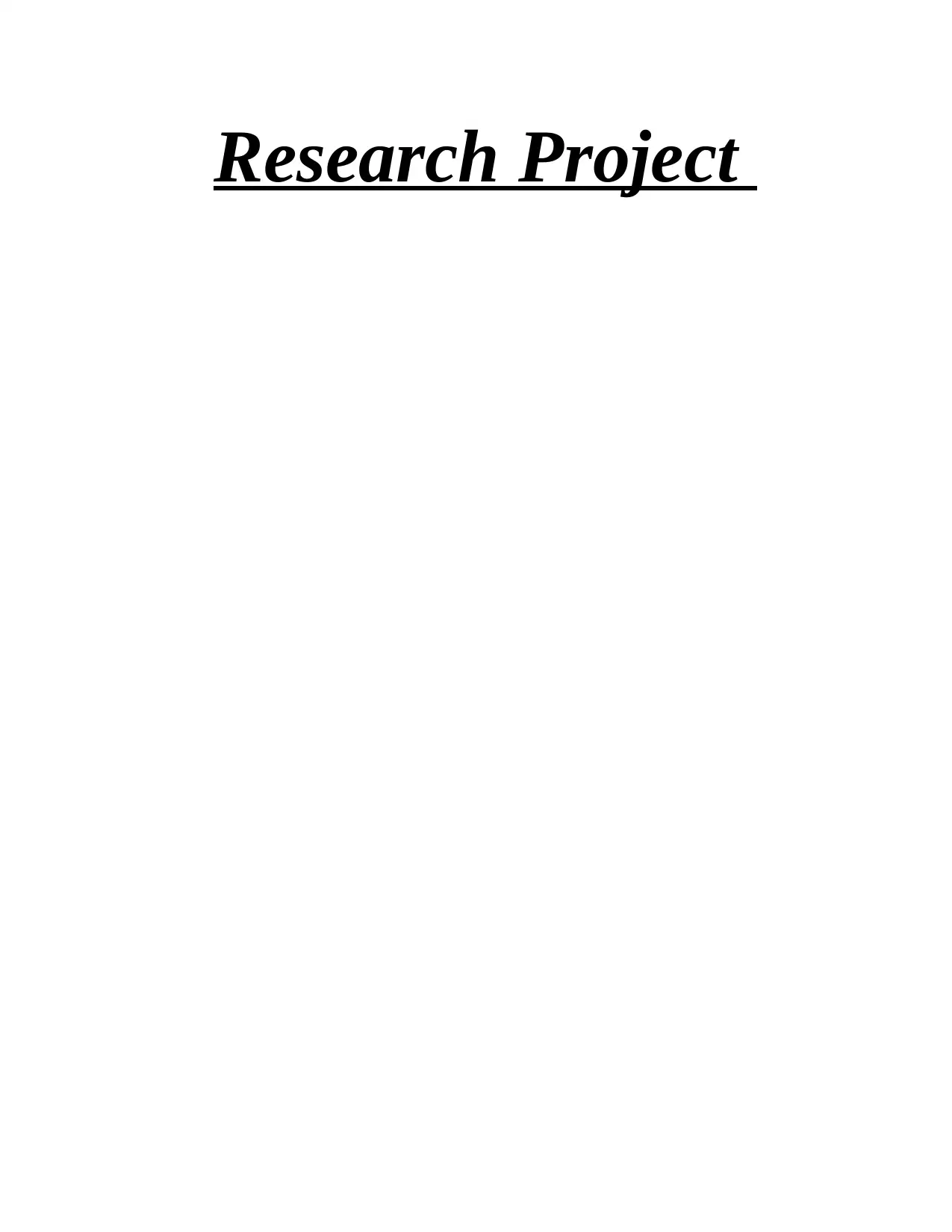
Research Project
Paraphrase This Document
Need a fresh take? Get an instant paraphrase of this document with our AI Paraphraser

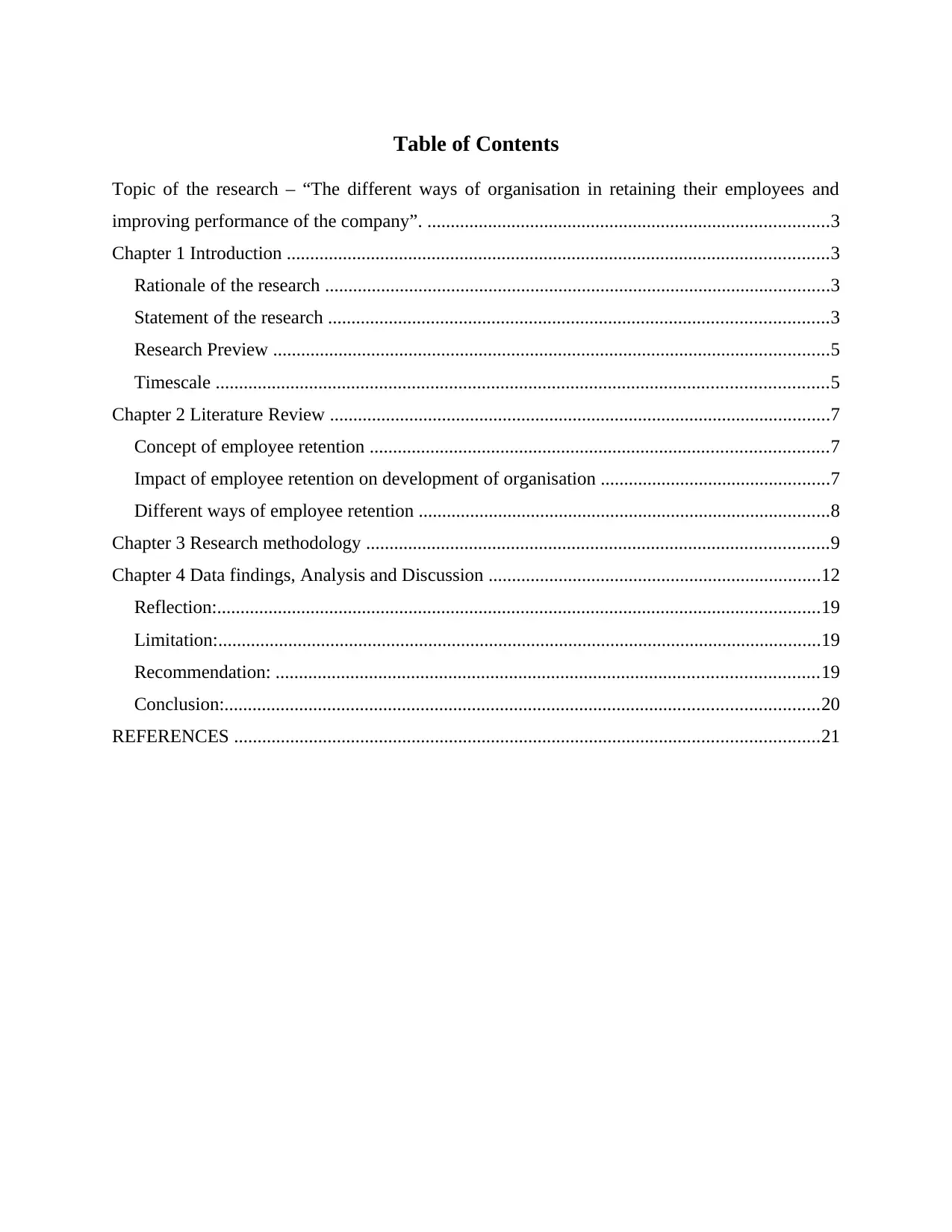
Table of Contents
Topic of the research – “The different ways of organisation in retaining their employees and
improving performance of the company”. ......................................................................................3
Chapter 1 Introduction ....................................................................................................................3
Rationale of the research ............................................................................................................3
Statement of the research ...........................................................................................................3
Research Preview .......................................................................................................................5
Timescale ...................................................................................................................................5
Chapter 2 Literature Review ...........................................................................................................7
Concept of employee retention ..................................................................................................7
Impact of employee retention on development of organisation .................................................7
Different ways of employee retention ........................................................................................8
Chapter 3 Research methodology ...................................................................................................9
Chapter 4 Data findings, Analysis and Discussion .......................................................................12
Reflection:.................................................................................................................................19
Limitation:.................................................................................................................................19
Recommendation: ....................................................................................................................19
Conclusion:...............................................................................................................................20
REFERENCES .............................................................................................................................21
Topic of the research – “The different ways of organisation in retaining their employees and
improving performance of the company”. ......................................................................................3
Chapter 1 Introduction ....................................................................................................................3
Rationale of the research ............................................................................................................3
Statement of the research ...........................................................................................................3
Research Preview .......................................................................................................................5
Timescale ...................................................................................................................................5
Chapter 2 Literature Review ...........................................................................................................7
Concept of employee retention ..................................................................................................7
Impact of employee retention on development of organisation .................................................7
Different ways of employee retention ........................................................................................8
Chapter 3 Research methodology ...................................................................................................9
Chapter 4 Data findings, Analysis and Discussion .......................................................................12
Reflection:.................................................................................................................................19
Limitation:.................................................................................................................................19
Recommendation: ....................................................................................................................19
Conclusion:...............................................................................................................................20
REFERENCES .............................................................................................................................21
⊘ This is a preview!⊘
Do you want full access?
Subscribe today to unlock all pages.

Trusted by 1+ million students worldwide
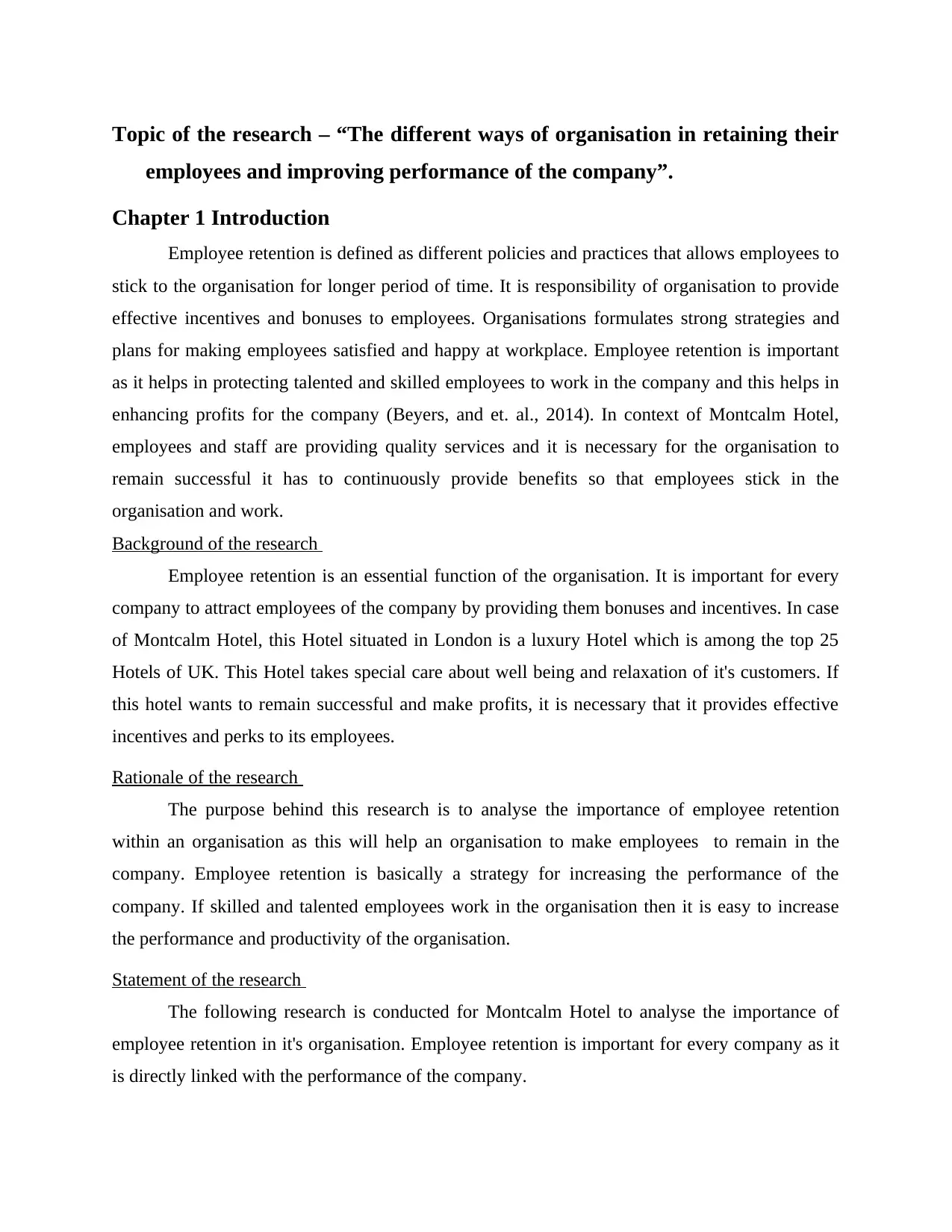
Topic of the research – “The different ways of organisation in retaining their
employees and improving performance of the company”.
Chapter 1 Introduction
Employee retention is defined as different policies and practices that allows employees to
stick to the organisation for longer period of time. It is responsibility of organisation to provide
effective incentives and bonuses to employees. Organisations formulates strong strategies and
plans for making employees satisfied and happy at workplace. Employee retention is important
as it helps in protecting talented and skilled employees to work in the company and this helps in
enhancing profits for the company (Beyers, and et. al., 2014). In context of Montcalm Hotel,
employees and staff are providing quality services and it is necessary for the organisation to
remain successful it has to continuously provide benefits so that employees stick in the
organisation and work.
Background of the research
Employee retention is an essential function of the organisation. It is important for every
company to attract employees of the company by providing them bonuses and incentives. In case
of Montcalm Hotel, this Hotel situated in London is a luxury Hotel which is among the top 25
Hotels of UK. This Hotel takes special care about well being and relaxation of it's customers. If
this hotel wants to remain successful and make profits, it is necessary that it provides effective
incentives and perks to its employees.
Rationale of the research
The purpose behind this research is to analyse the importance of employee retention
within an organisation as this will help an organisation to make employees to remain in the
company. Employee retention is basically a strategy for increasing the performance of the
company. If skilled and talented employees work in the organisation then it is easy to increase
the performance and productivity of the organisation.
Statement of the research
The following research is conducted for Montcalm Hotel to analyse the importance of
employee retention in it's organisation. Employee retention is important for every company as it
is directly linked with the performance of the company.
employees and improving performance of the company”.
Chapter 1 Introduction
Employee retention is defined as different policies and practices that allows employees to
stick to the organisation for longer period of time. It is responsibility of organisation to provide
effective incentives and bonuses to employees. Organisations formulates strong strategies and
plans for making employees satisfied and happy at workplace. Employee retention is important
as it helps in protecting talented and skilled employees to work in the company and this helps in
enhancing profits for the company (Beyers, and et. al., 2014). In context of Montcalm Hotel,
employees and staff are providing quality services and it is necessary for the organisation to
remain successful it has to continuously provide benefits so that employees stick in the
organisation and work.
Background of the research
Employee retention is an essential function of the organisation. It is important for every
company to attract employees of the company by providing them bonuses and incentives. In case
of Montcalm Hotel, this Hotel situated in London is a luxury Hotel which is among the top 25
Hotels of UK. This Hotel takes special care about well being and relaxation of it's customers. If
this hotel wants to remain successful and make profits, it is necessary that it provides effective
incentives and perks to its employees.
Rationale of the research
The purpose behind this research is to analyse the importance of employee retention
within an organisation as this will help an organisation to make employees to remain in the
company. Employee retention is basically a strategy for increasing the performance of the
company. If skilled and talented employees work in the organisation then it is easy to increase
the performance and productivity of the organisation.
Statement of the research
The following research is conducted for Montcalm Hotel to analyse the importance of
employee retention in it's organisation. Employee retention is important for every company as it
is directly linked with the performance of the company.
Paraphrase This Document
Need a fresh take? Get an instant paraphrase of this document with our AI Paraphraser

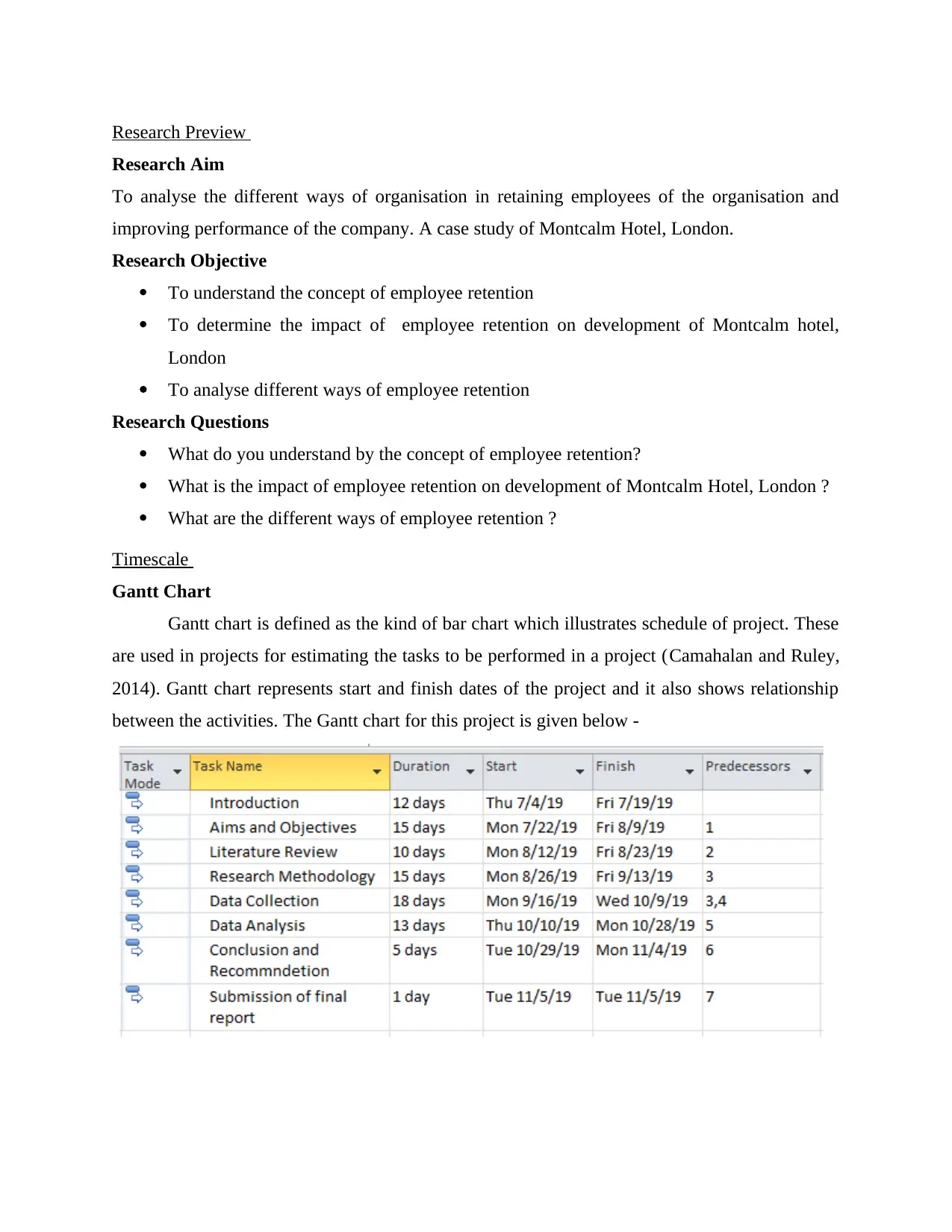
Research Preview
Research Aim
To analyse the different ways of organisation in retaining employees of the organisation and
improving performance of the company. A case study of Montcalm Hotel, London.
Research Objective
To understand the concept of employee retention
To determine the impact of employee retention on development of Montcalm hotel,
London
To analyse different ways of employee retention
Research Questions
What do you understand by the concept of employee retention?
What is the impact of employee retention on development of Montcalm Hotel, London ?
What are the different ways of employee retention ?
Timescale
Gantt Chart
Gantt chart is defined as the kind of bar chart which illustrates schedule of project. These
are used in projects for estimating the tasks to be performed in a project (Camahalan and Ruley,
2014). Gantt chart represents start and finish dates of the project and it also shows relationship
between the activities. The Gantt chart for this project is given below -
Research Aim
To analyse the different ways of organisation in retaining employees of the organisation and
improving performance of the company. A case study of Montcalm Hotel, London.
Research Objective
To understand the concept of employee retention
To determine the impact of employee retention on development of Montcalm hotel,
London
To analyse different ways of employee retention
Research Questions
What do you understand by the concept of employee retention?
What is the impact of employee retention on development of Montcalm Hotel, London ?
What are the different ways of employee retention ?
Timescale
Gantt Chart
Gantt chart is defined as the kind of bar chart which illustrates schedule of project. These
are used in projects for estimating the tasks to be performed in a project (Camahalan and Ruley,
2014). Gantt chart represents start and finish dates of the project and it also shows relationship
between the activities. The Gantt chart for this project is given below -
⊘ This is a preview!⊘
Do you want full access?
Subscribe today to unlock all pages.

Trusted by 1+ million students worldwide
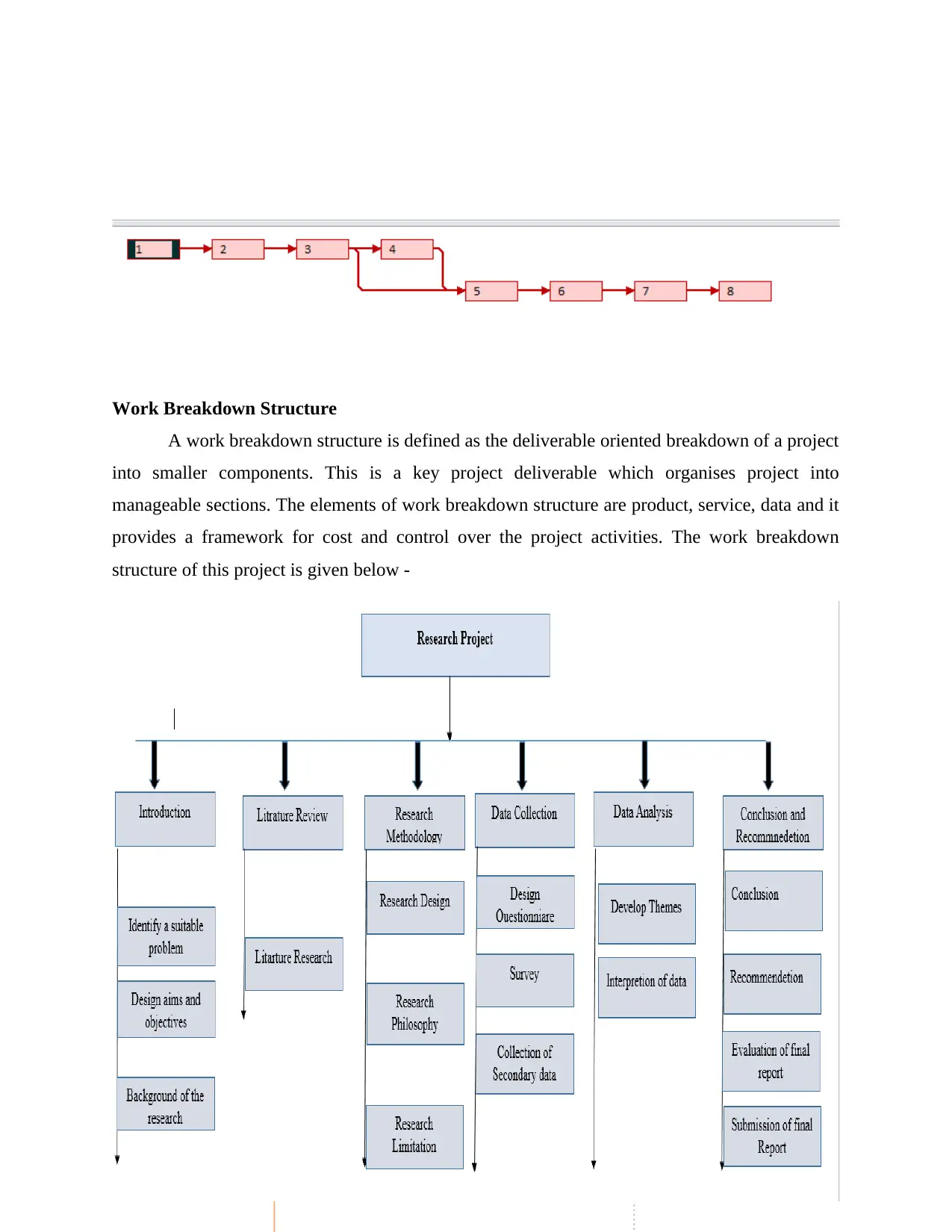
Work Breakdown Structure
A work breakdown structure is defined as the deliverable oriented breakdown of a project
into smaller components. This is a key project deliverable which organises project into
manageable sections. The elements of work breakdown structure are product, service, data and it
provides a framework for cost and control over the project activities. The work breakdown
structure of this project is given below -
A work breakdown structure is defined as the deliverable oriented breakdown of a project
into smaller components. This is a key project deliverable which organises project into
manageable sections. The elements of work breakdown structure are product, service, data and it
provides a framework for cost and control over the project activities. The work breakdown
structure of this project is given below -
Paraphrase This Document
Need a fresh take? Get an instant paraphrase of this document with our AI Paraphraser
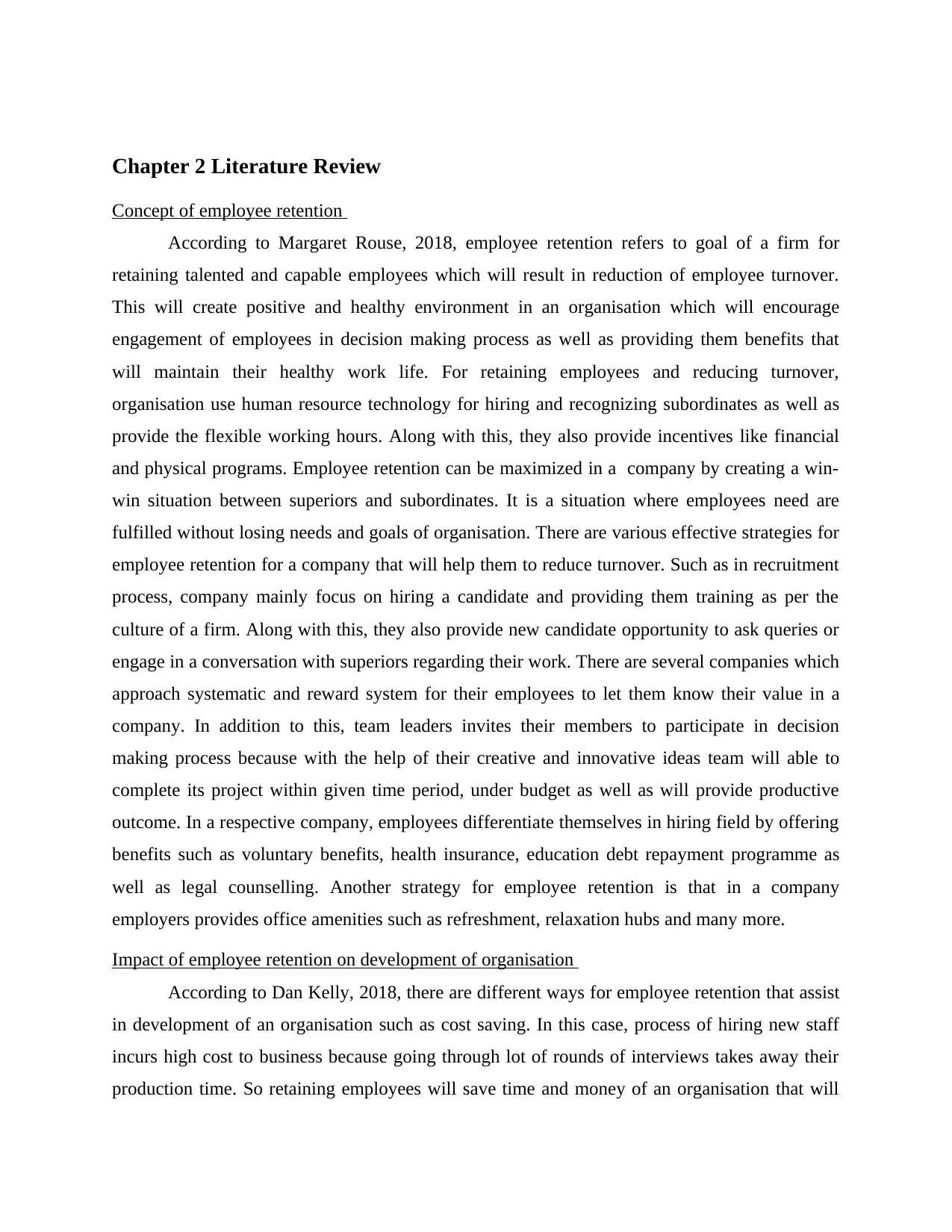
Chapter 2 Literature Review
Concept of employee retention
According to Margaret Rouse, 2018, employee retention refers to goal of a firm for
retaining talented and capable employees which will result in reduction of employee turnover.
This will create positive and healthy environment in an organisation which will encourage
engagement of employees in decision making process as well as providing them benefits that
will maintain their healthy work life. For retaining employees and reducing turnover,
organisation use human resource technology for hiring and recognizing subordinates as well as
provide the flexible working hours. Along with this, they also provide incentives like financial
and physical programs. Employee retention can be maximized in a company by creating a win-
win situation between superiors and subordinates. It is a situation where employees need are
fulfilled without losing needs and goals of organisation. There are various effective strategies for
employee retention for a company that will help them to reduce turnover. Such as in recruitment
process, company mainly focus on hiring a candidate and providing them training as per the
culture of a firm. Along with this, they also provide new candidate opportunity to ask queries or
engage in a conversation with superiors regarding their work. There are several companies which
approach systematic and reward system for their employees to let them know their value in a
company. In addition to this, team leaders invites their members to participate in decision
making process because with the help of their creative and innovative ideas team will able to
complete its project within given time period, under budget as well as will provide productive
outcome. In a respective company, employees differentiate themselves in hiring field by offering
benefits such as voluntary benefits, health insurance, education debt repayment programme as
well as legal counselling. Another strategy for employee retention is that in a company
employers provides office amenities such as refreshment, relaxation hubs and many more.
Impact of employee retention on development of organisation
According to Dan Kelly, 2018, there are different ways for employee retention that assist
in development of an organisation such as cost saving. In this case, process of hiring new staff
incurs high cost to business because going through lot of rounds of interviews takes away their
production time. So retaining employees will save time and money of an organisation that will
Concept of employee retention
According to Margaret Rouse, 2018, employee retention refers to goal of a firm for
retaining talented and capable employees which will result in reduction of employee turnover.
This will create positive and healthy environment in an organisation which will encourage
engagement of employees in decision making process as well as providing them benefits that
will maintain their healthy work life. For retaining employees and reducing turnover,
organisation use human resource technology for hiring and recognizing subordinates as well as
provide the flexible working hours. Along with this, they also provide incentives like financial
and physical programs. Employee retention can be maximized in a company by creating a win-
win situation between superiors and subordinates. It is a situation where employees need are
fulfilled without losing needs and goals of organisation. There are various effective strategies for
employee retention for a company that will help them to reduce turnover. Such as in recruitment
process, company mainly focus on hiring a candidate and providing them training as per the
culture of a firm. Along with this, they also provide new candidate opportunity to ask queries or
engage in a conversation with superiors regarding their work. There are several companies which
approach systematic and reward system for their employees to let them know their value in a
company. In addition to this, team leaders invites their members to participate in decision
making process because with the help of their creative and innovative ideas team will able to
complete its project within given time period, under budget as well as will provide productive
outcome. In a respective company, employees differentiate themselves in hiring field by offering
benefits such as voluntary benefits, health insurance, education debt repayment programme as
well as legal counselling. Another strategy for employee retention is that in a company
employers provides office amenities such as refreshment, relaxation hubs and many more.
Impact of employee retention on development of organisation
According to Dan Kelly, 2018, there are different ways for employee retention that assist
in development of an organisation such as cost saving. In this case, process of hiring new staff
incurs high cost to business because going through lot of rounds of interviews takes away their
production time. So retaining employees will save time and money of an organisation that will
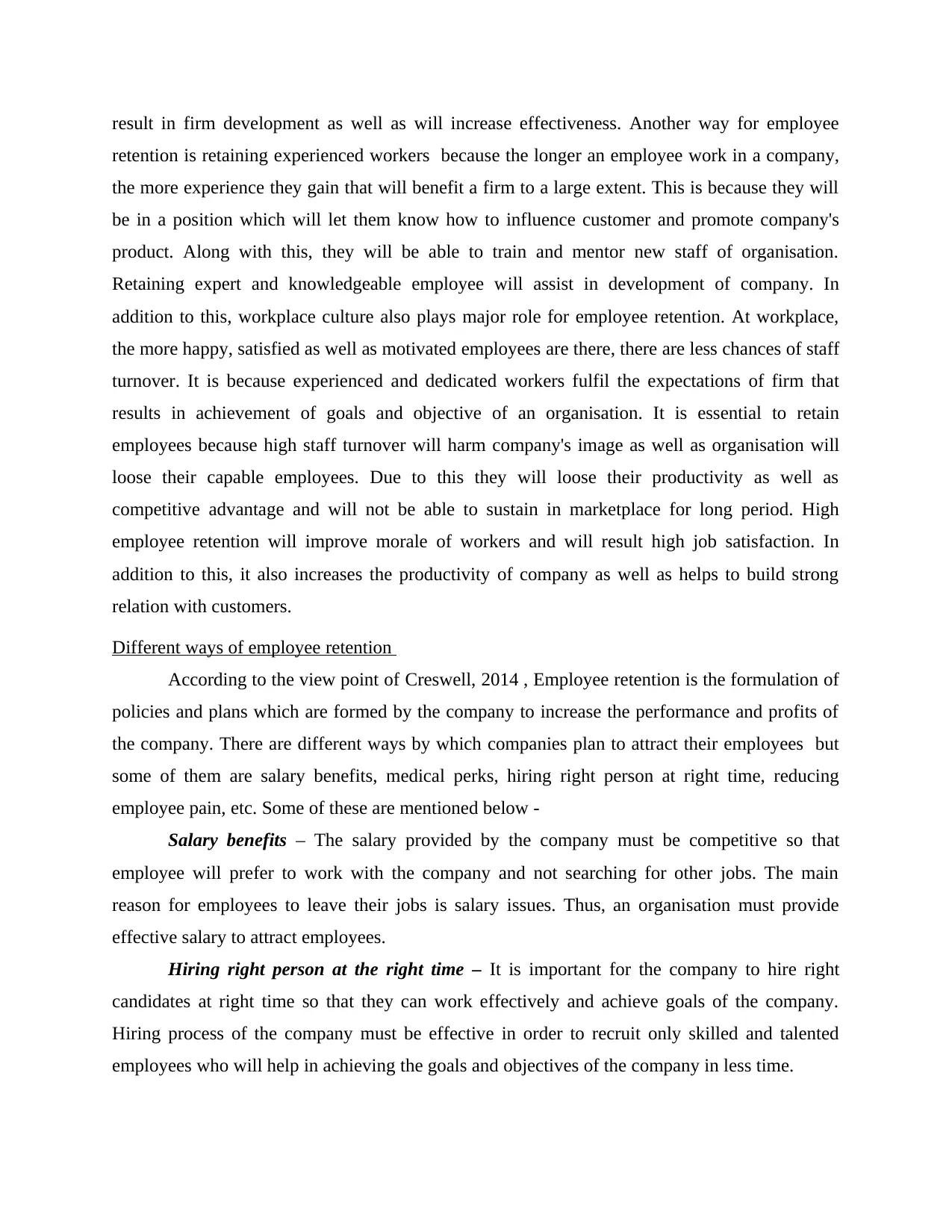
result in firm development as well as will increase effectiveness. Another way for employee
retention is retaining experienced workers because the longer an employee work in a company,
the more experience they gain that will benefit a firm to a large extent. This is because they will
be in a position which will let them know how to influence customer and promote company's
product. Along with this, they will be able to train and mentor new staff of organisation.
Retaining expert and knowledgeable employee will assist in development of company. In
addition to this, workplace culture also plays major role for employee retention. At workplace,
the more happy, satisfied as well as motivated employees are there, there are less chances of staff
turnover. It is because experienced and dedicated workers fulfil the expectations of firm that
results in achievement of goals and objective of an organisation. It is essential to retain
employees because high staff turnover will harm company's image as well as organisation will
loose their capable employees. Due to this they will loose their productivity as well as
competitive advantage and will not be able to sustain in marketplace for long period. High
employee retention will improve morale of workers and will result high job satisfaction. In
addition to this, it also increases the productivity of company as well as helps to build strong
relation with customers.
Different ways of employee retention
According to the view point of Creswell, 2014 , Employee retention is the formulation of
policies and plans which are formed by the company to increase the performance and profits of
the company. There are different ways by which companies plan to attract their employees but
some of them are salary benefits, medical perks, hiring right person at right time, reducing
employee pain, etc. Some of these are mentioned below -
Salary benefits – The salary provided by the company must be competitive so that
employee will prefer to work with the company and not searching for other jobs. The main
reason for employees to leave their jobs is salary issues. Thus, an organisation must provide
effective salary to attract employees.
Hiring right person at the right time – It is important for the company to hire right
candidates at right time so that they can work effectively and achieve goals of the company.
Hiring process of the company must be effective in order to recruit only skilled and talented
employees who will help in achieving the goals and objectives of the company in less time.
retention is retaining experienced workers because the longer an employee work in a company,
the more experience they gain that will benefit a firm to a large extent. This is because they will
be in a position which will let them know how to influence customer and promote company's
product. Along with this, they will be able to train and mentor new staff of organisation.
Retaining expert and knowledgeable employee will assist in development of company. In
addition to this, workplace culture also plays major role for employee retention. At workplace,
the more happy, satisfied as well as motivated employees are there, there are less chances of staff
turnover. It is because experienced and dedicated workers fulfil the expectations of firm that
results in achievement of goals and objective of an organisation. It is essential to retain
employees because high staff turnover will harm company's image as well as organisation will
loose their capable employees. Due to this they will loose their productivity as well as
competitive advantage and will not be able to sustain in marketplace for long period. High
employee retention will improve morale of workers and will result high job satisfaction. In
addition to this, it also increases the productivity of company as well as helps to build strong
relation with customers.
Different ways of employee retention
According to the view point of Creswell, 2014 , Employee retention is the formulation of
policies and plans which are formed by the company to increase the performance and profits of
the company. There are different ways by which companies plan to attract their employees but
some of them are salary benefits, medical perks, hiring right person at right time, reducing
employee pain, etc. Some of these are mentioned below -
Salary benefits – The salary provided by the company must be competitive so that
employee will prefer to work with the company and not searching for other jobs. The main
reason for employees to leave their jobs is salary issues. Thus, an organisation must provide
effective salary to attract employees.
Hiring right person at the right time – It is important for the company to hire right
candidates at right time so that they can work effectively and achieve goals of the company.
Hiring process of the company must be effective in order to recruit only skilled and talented
employees who will help in achieving the goals and objectives of the company in less time.
⊘ This is a preview!⊘
Do you want full access?
Subscribe today to unlock all pages.

Trusted by 1+ million students worldwide
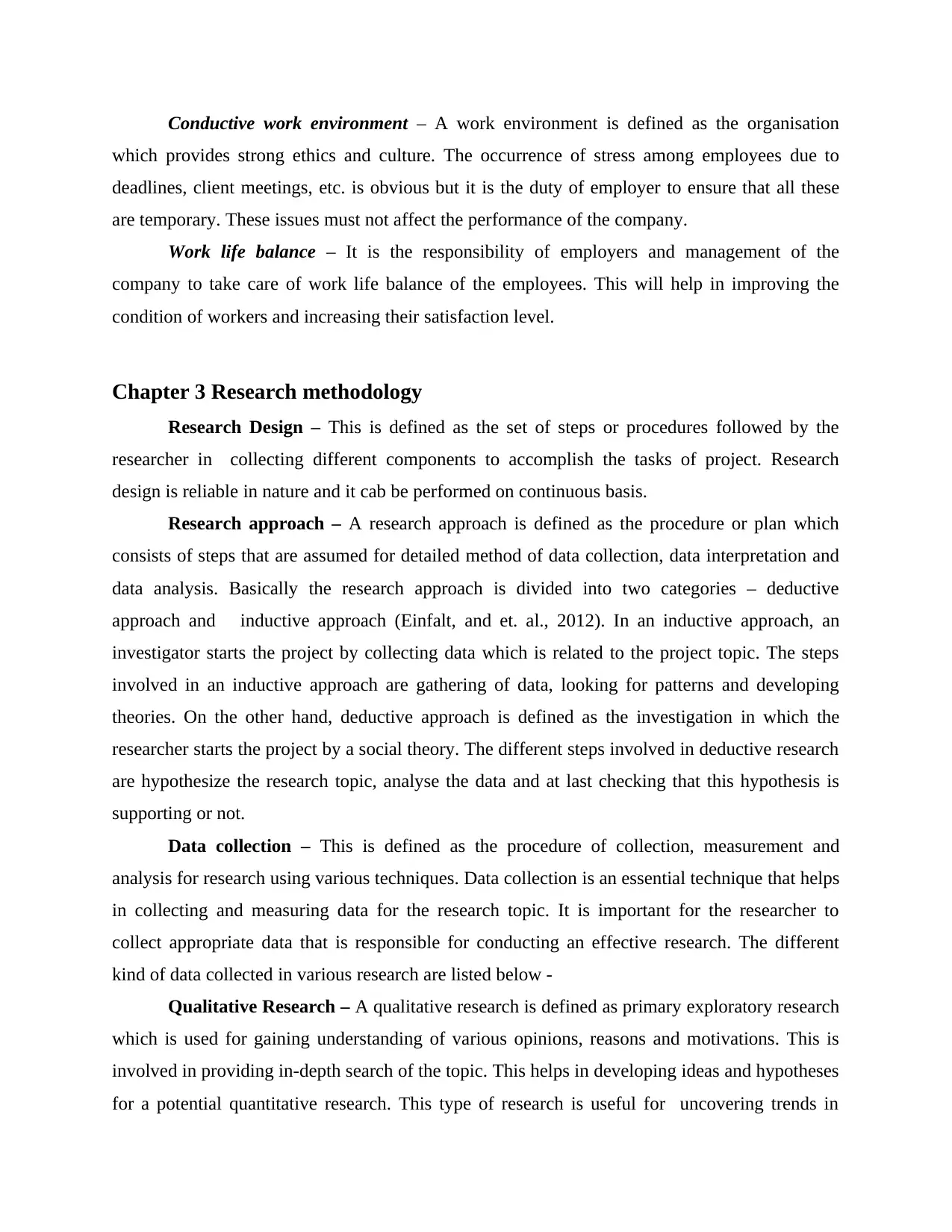
Conductive work environment – A work environment is defined as the organisation
which provides strong ethics and culture. The occurrence of stress among employees due to
deadlines, client meetings, etc. is obvious but it is the duty of employer to ensure that all these
are temporary. These issues must not affect the performance of the company.
Work life balance – It is the responsibility of employers and management of the
company to take care of work life balance of the employees. This will help in improving the
condition of workers and increasing their satisfaction level.
Chapter 3 Research methodology
Research Design – This is defined as the set of steps or procedures followed by the
researcher in collecting different components to accomplish the tasks of project. Research
design is reliable in nature and it cab be performed on continuous basis.
Research approach – A research approach is defined as the procedure or plan which
consists of steps that are assumed for detailed method of data collection, data interpretation and
data analysis. Basically the research approach is divided into two categories – deductive
approach and inductive approach (Einfalt, and et. al., 2012). In an inductive approach, an
investigator starts the project by collecting data which is related to the project topic. The steps
involved in an inductive approach are gathering of data, looking for patterns and developing
theories. On the other hand, deductive approach is defined as the investigation in which the
researcher starts the project by a social theory. The different steps involved in deductive research
are hypothesize the research topic, analyse the data and at last checking that this hypothesis is
supporting or not.
Data collection – This is defined as the procedure of collection, measurement and
analysis for research using various techniques. Data collection is an essential technique that helps
in collecting and measuring data for the research topic. It is important for the researcher to
collect appropriate data that is responsible for conducting an effective research. The different
kind of data collected in various research are listed below -
Qualitative Research – A qualitative research is defined as primary exploratory research
which is used for gaining understanding of various opinions, reasons and motivations. This is
involved in providing in-depth search of the topic. This helps in developing ideas and hypotheses
for a potential quantitative research. This type of research is useful for uncovering trends in
which provides strong ethics and culture. The occurrence of stress among employees due to
deadlines, client meetings, etc. is obvious but it is the duty of employer to ensure that all these
are temporary. These issues must not affect the performance of the company.
Work life balance – It is the responsibility of employers and management of the
company to take care of work life balance of the employees. This will help in improving the
condition of workers and increasing their satisfaction level.
Chapter 3 Research methodology
Research Design – This is defined as the set of steps or procedures followed by the
researcher in collecting different components to accomplish the tasks of project. Research
design is reliable in nature and it cab be performed on continuous basis.
Research approach – A research approach is defined as the procedure or plan which
consists of steps that are assumed for detailed method of data collection, data interpretation and
data analysis. Basically the research approach is divided into two categories – deductive
approach and inductive approach (Einfalt, and et. al., 2012). In an inductive approach, an
investigator starts the project by collecting data which is related to the project topic. The steps
involved in an inductive approach are gathering of data, looking for patterns and developing
theories. On the other hand, deductive approach is defined as the investigation in which the
researcher starts the project by a social theory. The different steps involved in deductive research
are hypothesize the research topic, analyse the data and at last checking that this hypothesis is
supporting or not.
Data collection – This is defined as the procedure of collection, measurement and
analysis for research using various techniques. Data collection is an essential technique that helps
in collecting and measuring data for the research topic. It is important for the researcher to
collect appropriate data that is responsible for conducting an effective research. The different
kind of data collected in various research are listed below -
Qualitative Research – A qualitative research is defined as primary exploratory research
which is used for gaining understanding of various opinions, reasons and motivations. This is
involved in providing in-depth search of the topic. This helps in developing ideas and hypotheses
for a potential quantitative research. This type of research is useful for uncovering trends in
Paraphrase This Document
Need a fresh take? Get an instant paraphrase of this document with our AI Paraphraser
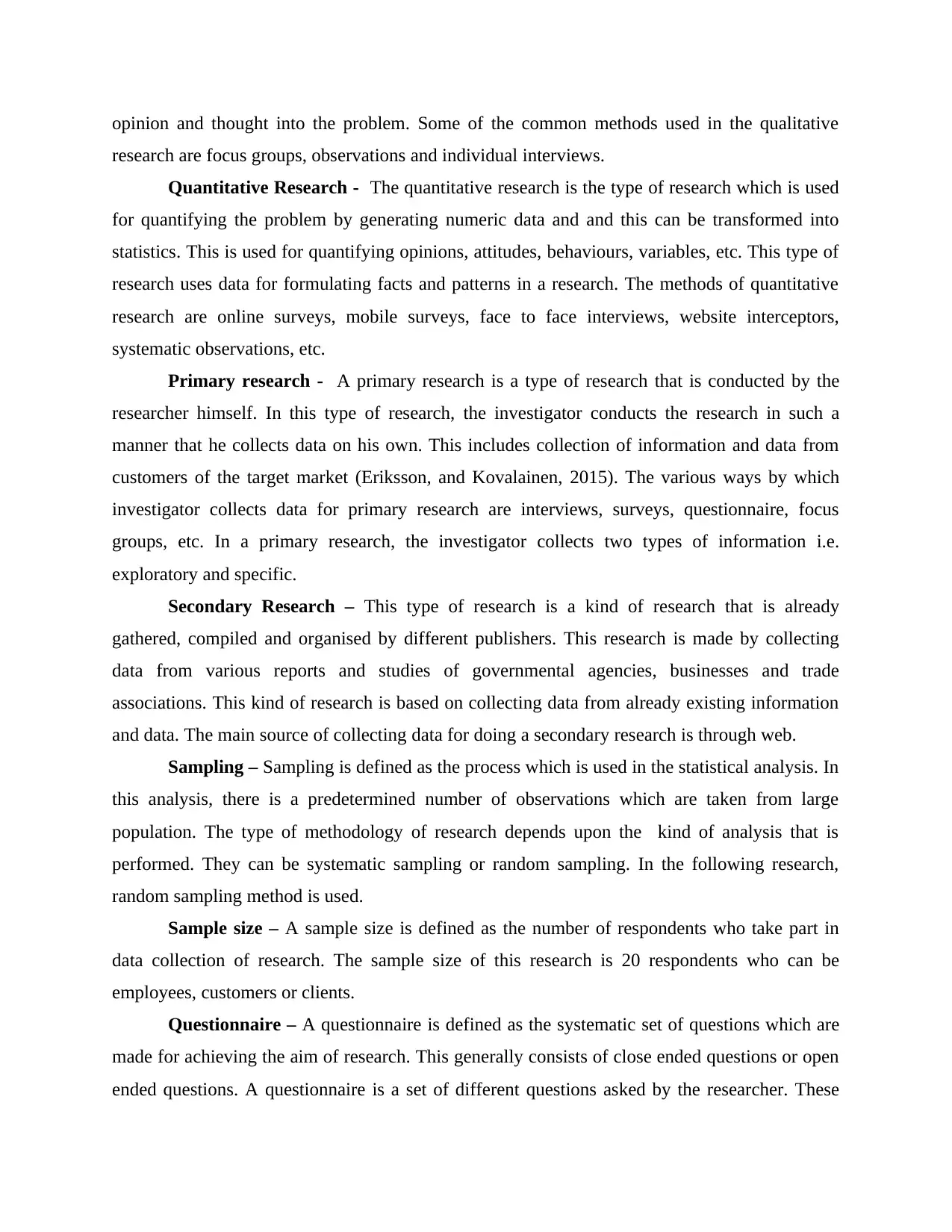
opinion and thought into the problem. Some of the common methods used in the qualitative
research are focus groups, observations and individual interviews.
Quantitative Research - The quantitative research is the type of research which is used
for quantifying the problem by generating numeric data and and this can be transformed into
statistics. This is used for quantifying opinions, attitudes, behaviours, variables, etc. This type of
research uses data for formulating facts and patterns in a research. The methods of quantitative
research are online surveys, mobile surveys, face to face interviews, website interceptors,
systematic observations, etc.
Primary research - A primary research is a type of research that is conducted by the
researcher himself. In this type of research, the investigator conducts the research in such a
manner that he collects data on his own. This includes collection of information and data from
customers of the target market (Eriksson, and Kovalainen, 2015). The various ways by which
investigator collects data for primary research are interviews, surveys, questionnaire, focus
groups, etc. In a primary research, the investigator collects two types of information i.e.
exploratory and specific.
Secondary Research – This type of research is a kind of research that is already
gathered, compiled and organised by different publishers. This research is made by collecting
data from various reports and studies of governmental agencies, businesses and trade
associations. This kind of research is based on collecting data from already existing information
and data. The main source of collecting data for doing a secondary research is through web.
Sampling – Sampling is defined as the process which is used in the statistical analysis. In
this analysis, there is a predetermined number of observations which are taken from large
population. The type of methodology of research depends upon the kind of analysis that is
performed. They can be systematic sampling or random sampling. In the following research,
random sampling method is used.
Sample size – A sample size is defined as the number of respondents who take part in
data collection of research. The sample size of this research is 20 respondents who can be
employees, customers or clients.
Questionnaire – A questionnaire is defined as the systematic set of questions which are
made for achieving the aim of research. This generally consists of close ended questions or open
ended questions. A questionnaire is a set of different questions asked by the researcher. These
research are focus groups, observations and individual interviews.
Quantitative Research - The quantitative research is the type of research which is used
for quantifying the problem by generating numeric data and and this can be transformed into
statistics. This is used for quantifying opinions, attitudes, behaviours, variables, etc. This type of
research uses data for formulating facts and patterns in a research. The methods of quantitative
research are online surveys, mobile surveys, face to face interviews, website interceptors,
systematic observations, etc.
Primary research - A primary research is a type of research that is conducted by the
researcher himself. In this type of research, the investigator conducts the research in such a
manner that he collects data on his own. This includes collection of information and data from
customers of the target market (Eriksson, and Kovalainen, 2015). The various ways by which
investigator collects data for primary research are interviews, surveys, questionnaire, focus
groups, etc. In a primary research, the investigator collects two types of information i.e.
exploratory and specific.
Secondary Research – This type of research is a kind of research that is already
gathered, compiled and organised by different publishers. This research is made by collecting
data from various reports and studies of governmental agencies, businesses and trade
associations. This kind of research is based on collecting data from already existing information
and data. The main source of collecting data for doing a secondary research is through web.
Sampling – Sampling is defined as the process which is used in the statistical analysis. In
this analysis, there is a predetermined number of observations which are taken from large
population. The type of methodology of research depends upon the kind of analysis that is
performed. They can be systematic sampling or random sampling. In the following research,
random sampling method is used.
Sample size – A sample size is defined as the number of respondents who take part in
data collection of research. The sample size of this research is 20 respondents who can be
employees, customers or clients.
Questionnaire – A questionnaire is defined as the systematic set of questions which are
made for achieving the aim of research. This generally consists of close ended questions or open
ended questions. A questionnaire is a set of different questions asked by the researcher. These
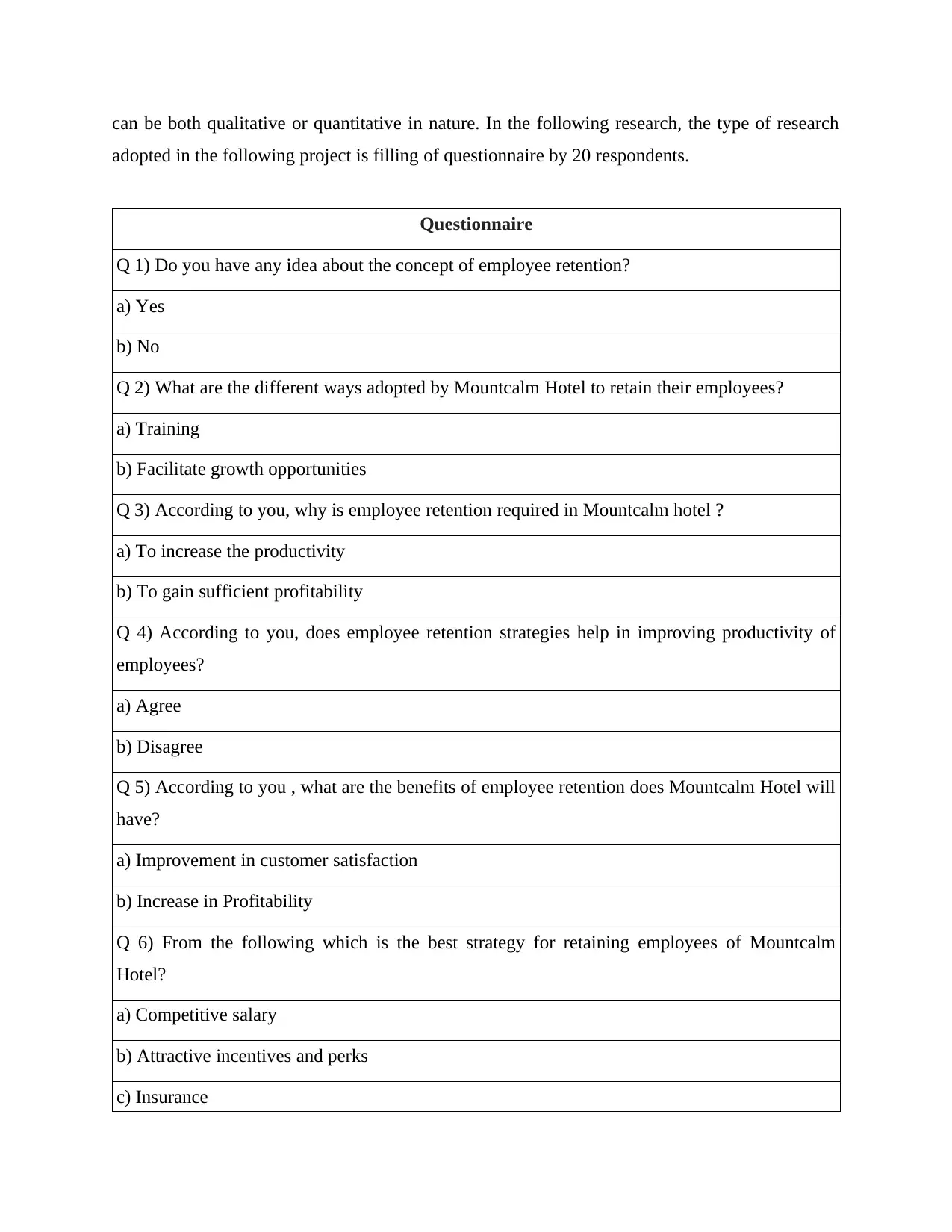
can be both qualitative or quantitative in nature. In the following research, the type of research
adopted in the following project is filling of questionnaire by 20 respondents.
Questionnaire
Q 1) Do you have any idea about the concept of employee retention?
a) Yes
b) No
Q 2) What are the different ways adopted by Mountcalm Hotel to retain their employees?
a) Training
b) Facilitate growth opportunities
Q 3) According to you, why is employee retention required in Mountcalm hotel ?
a) To increase the productivity
b) To gain sufficient profitability
Q 4) According to you, does employee retention strategies help in improving productivity of
employees?
a) Agree
b) Disagree
Q 5) According to you , what are the benefits of employee retention does Mountcalm Hotel will
have?
a) Improvement in customer satisfaction
b) Increase in Profitability
Q 6) From the following which is the best strategy for retaining employees of Mountcalm
Hotel?
a) Competitive salary
b) Attractive incentives and perks
c) Insurance
adopted in the following project is filling of questionnaire by 20 respondents.
Questionnaire
Q 1) Do you have any idea about the concept of employee retention?
a) Yes
b) No
Q 2) What are the different ways adopted by Mountcalm Hotel to retain their employees?
a) Training
b) Facilitate growth opportunities
Q 3) According to you, why is employee retention required in Mountcalm hotel ?
a) To increase the productivity
b) To gain sufficient profitability
Q 4) According to you, does employee retention strategies help in improving productivity of
employees?
a) Agree
b) Disagree
Q 5) According to you , what are the benefits of employee retention does Mountcalm Hotel will
have?
a) Improvement in customer satisfaction
b) Increase in Profitability
Q 6) From the following which is the best strategy for retaining employees of Mountcalm
Hotel?
a) Competitive salary
b) Attractive incentives and perks
c) Insurance
⊘ This is a preview!⊘
Do you want full access?
Subscribe today to unlock all pages.

Trusted by 1+ million students worldwide
1 out of 24
Related Documents
Your All-in-One AI-Powered Toolkit for Academic Success.
+13062052269
info@desklib.com
Available 24*7 on WhatsApp / Email
![[object Object]](/_next/static/media/star-bottom.7253800d.svg)
Unlock your academic potential
Copyright © 2020–2025 A2Z Services. All Rights Reserved. Developed and managed by ZUCOL.





